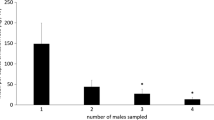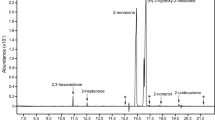Abstract
The response of nymphal and adult gregarious phase desert locust,Schistocerca gregaria, to a choice of two columns of air, one permeated with airborne volatiles emanating from nymphs or adults and the other untreated, was investigated in a single-chamber bioassay arena. The nymphs, whether released individually or in groups, preferred to be within the precinct of the air column treated with airborne volatiles of the nymphs but were indifferent to volatiles of the adults. Conversely, older adults responded only to their own volatiles but not to those of the nymphs or young adults. The young adults were responsive only to volatiles of the older adults. Charcoal-trapped volatiles from the nymphs and the adults reproduced the effect of living locusts. These results indicate that there are two different aggregation pheromones inS. gregaria: a juvenile pheromone produced by nymphs and an adult pheromone specific to adults.
Similar content being viewed by others
References
Amerasinghe, F.P. 1978. Pheromonal effects on sexual maturation, yellowing, and the vibration reaction on immature male desert locusts (Schistocerca gregaria).J. Insect Physiol. 24:309–314.
Chauvin, R. 1941. Contribution a l'étude physiologique du criquet pelerin et du determinsme des phenomenes gregaires.Ann. Soc. Entomol. France 1:1–173.
Ellis, P.E. 1959. Learning and social aggregation in locust hoppers.Anim. Behav. 7:91–106.
Ellis, P.E. 1962. The behaviour of locusts in relation to phases and species.Colloq. Int. C.N.R.S. 114:123–143.
Ellis, P.E., andPearce, A. 1962. Innate and learned behaviour patterns that lead to group formation in locust hoppers.Anim. Behav. 10:305–318.
Fuzeau-Braesch, E., Genin, E., Jullien, R., Knowles, E., andPapin, C. 1988. Composition and role of volatile substances in the atmosphere surrounding two gregarious locusts,Locusta migratoria and Schistocerca gregaria.J. Chem. Ecol. 14:1023–1033.
Gillett, S.D. 1968. Airborne factor affecting the grouping behaviour of locusts.Nature 218:782–783.
Gillett, S.D. 1975. Changes in the social behaviour of the desert locust,Schistocerca gregaria, in response to the gregarisation pheromone.Anim. Behav. 23:494–503.
Gillett, S.D. 1983. Primer pheromones and polymorphism in the desert locust.Anim. Behav. 31:221–230.
Gillett, S.D., andPhillips, M. 1977. Faeces as a source of a locust gregarisation stimulus. Effects on social aggregation and on cuticular colour of nymphs of the desert locust,Schistocerca gregaria (Forskal).Acrida 6:279–286.
Gillett, S.D., Packham, J.M., andPapworth, S.J. 1976. Possible pheromonal effects on aggregation and dispersion in the desert locust,Schistocerca gregaria.Acrida 4:287–298.
Jackson, G.J.,Popov, G.B.,Ibrahim, A.O.,Alghamodi, S.A., andKhan, A.M. 1978. Effects of food plants on the development, maturation, fecundity and phase of the desert locust,Schistocerca gregaria (Forskal). Centre for Overseas Plant Research, Miscellaneous Report No. 42.
Loher, W. 1960. The chemical acceleration of the maturation process and its hormonal control in the male of the desert locust.Proc. R. Soc. London Ser. B. 153:380–397.
Michel, R. 1980. Development of flight behaviour of inccessive generations of desert locust (Schistocerca gregaria) revised isolation then in groups.Anim. Behav. 28:1288–1289.
Nolte, D.J. 1963. A pheromone for melanization of locusts.Nature 200:660–661.
Nolte, D.J. 1968. The chiasma-inducing pheromone of locusts.Chromosoma 23:346–358.
Nolte, D.J. 1976. Locustol and its analogues.J. Insect Physiol. 22:833–838.
Nolte, D.J., May, I.R., andThomas, B.M. 1970. The gregarisation pheromone of locusts.Chromosoma 29:462–473.
Nolte, D.J., Eggers, S.H., andMay, I.R. 1973. Locust pheromone: Locustol.J. Insect Physiol. 19:1547–1554.
Morris, M.J. 1962. Group effects on the activity and behaviour of adult males of the desert locust (Schistocerca gregaria Forsk.) in relation to sexual maturation.Anim. Behav. 10:275–291.
Norris, M.J. 1963. Laboratory experiments on gregarious behaviour in ovipositing females of the desert locust,Schistocerca gregaria (Forsk.).Entomol. Exp. Appl. 6:279–363.
Norris, M.J. 1964. Accelerating and inhibiting crowding on sexual maturation in two species of locusts.Nature 203:784–785.
Popov, G.B. 1958. Ecological studies on oviposition by swarms of the desert locustSchistocerca gregaria (Forsk.).Entomol. Exp. Appl. 6:279–303.
Steedman, A. (ed.). 1988. Locust Handbook, 2nd ed. Overseas Development Natural Resource Institute, London, 180 pp.
Stower, W.J., Popov, G.B., andGreenhead, D.J. 1958. Oviposition behaviour and egg mortality of the desert locust (Schistocerca gregaria Forskal) on the coast of Eritrea.Anti-locust Bull. 30:1–33.
Uvarov, B.P. 1966. Grasshoppers and Locusts. Cambridge University Press, Cambridge, 496 pp.
Whitman, D.W. 1990. Grasshopper chemical communication, pp. 357–391,in R. Chapman and A. Joern (eds.). Biology of Grasshoppers. John Wiley, New York.
Author information
Authors and Affiliations
Rights and permissions
About this article
Cite this article
Obeng-Ofori, D., Torto, B. & Hassanali, A. Evidence for mediation of two releaser pheromones in the aggregation behavior of the gregarious desert locust,Schistocerca gregaria (forskal) (Orthoptera: Acrididae). J Chem Ecol 19, 1665–1676 (1993). https://doi.org/10.1007/BF00982299
Received:
Accepted:
Issue Date:
DOI: https://doi.org/10.1007/BF00982299




